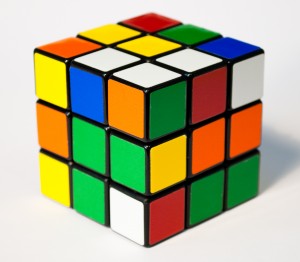Race for the Galaxy is a card game of interstellar development, with various factions sprinting to acquire the most economic, social, or military power to emerge as the dominant civilization in the galaxy. Since it’s release in 2007, it has enjoyed great popularity worldwide, earning multiple awards all over the globe. Rio Grande Games has kept an open line to their customer base, adding blank cards to expansions for players to experiment with and accepting submissions for card designs in contests. Each of its expansions adds new cards and mechanics to represent the changing backdrop of galactic events. Some of these additions have altered gameplay enough to be deemed Variants in their own right.
The Takeover mechanic in particular, introduced in the second expansion, Rebel vs Imperium, allows players to directly interfere with their opponents’ tableau. This is enough of a shift in focus from the game’s “Multiplayer Solitaire” origins that many players opt to remove or ignore any card abilities that reference Takeovers at all. If you wish for direct conflict in your games, there certainly is not a lack of those to choose from.
The Prestige mechanic in the third expansion, The Brink of War, opens yet another strategic path to victory, but enough people stumble over the added complexity that its use has also been deemed largely optional.
For a game that has experienced such popularity and introduced such variety of gameplay, Race has a surprisingly small number of Variants in the gaming community. Most people who play seem to enjoy the rules as they’re written. One of my fellow reviewers commented that, “It’s good just as it is!” It may also be that the highly ordered turn structure is fundamental enough to the game to make adaptation difficult. Most variants seem to be fan-made cards, running the gamut from inspired to overly complicated. But more on that later…
Thematic Variants
While Race for the Galaxy and its expansions do follow a story arc, and the various factions or planets all have plenty of flavor in their mechanics, there is overall very little in-game narrative cohesion pulling it together. While some players have expressed a wish for additional flavor text for backstory uses, designer Tom Lehmann has come out and said the absence of this is deliberate:
“… it is intentional on my part that there is no flavor text. I personally prefer no flavor text on cards as I think it inhibits players from being able to tell their own story around a given game.”
Also, one look at the cards themselves would tell you that adding more text would start to clutter the design a little too much.
Quite simply, it is not a storytelling game. That’s not to say that you can’t piece together your empire’s growth and challenges through the cards you play. Rather, it’s just that the links aren’t immediately obvious in the cards themselves. In Race, mechanics trump flavor to such an extent that trying to change the theme (or add to it) largely misses the point of the game itself.
That said, there is a two player “Official Variant” included with Rebel vs Imperium that attempts to assign roles, where one player’s start world is “Rebel Cantina” and the other’s is “Imperium Warlord”. The Rebel player gets “Rebel Alliance” in her starting hand, while her Imperial counterpart takes the “Imperium Seat”. That’s it; there are no other changes. So, while you’re military strategy is pretty fleshed out from the start with this one, gameplay isn’t terribly affected. You have the advantage with one faction, and soft-locked out of the other.
Gameplay Tweaks
We can do better than that. We’ll start with some tiny ones. After every game of Race I play, I go through the deck and pull out all the Start Worlds for the next game. It’s a small thing, but it does bug me a little, especially since I never play just one game but several in a row. One of the things I like about it is how simple it is to reset when the game ends: push all the VP chips into a pile, shuffle all the cards together, and start dealing. Having to fish out all the numbered planets is a small annoyance with an easy fix. Ready?
Copy the Start Worlds. Yeah, you heard me. Photocopy them, laminate those with tape, and you’re set. At the start of your game, deal them out randomly as normal, and put the unused ones back in the box with the rules and the extra Player Aids. If you draw your actual Start World from the deck later in the game, you obviously can’t play it, but there are already (a few) duplicates in the game so you’re not increasing your odds of a “dead draw” too drastically. And besides, you pitch plenty of cards throughtout the game anyways.
It’s a small fix for a small irk. Moving along…
Another way to jumpstart your openings is to play with the “Galactic Science” Variant. Before dealing the starting hands, reveal cards from the top of the deck until you find two developments, discarding any worlds revealed this way. Place those developments in the middle of the play area. These developments are considered to be in every player’s tableau for purposes of powers and scoring, but they do not count towards the number of cards you may have in play for triggering the end of the game. It serves as a quick accelerant, and guarantees more variety in a game already filled with it.
Alternatively, another easy variation altering the flow of the game involves a bit of randomness. In the expansion The Gathering Storm we were introduced to Goals, gaining VPs for achieving certain conditions in the game. The first player to place a Six-cost development, the first player to have at least three Alien cards in their tableau, the player with the most production worlds (minimum 4), etc., etc. One Goal-oriented Variant I’ve seen is the use of “hidden” Goals. Instead of the normal public distribution, each player instead draws one “Most” Goal and two “First” Goals. You’re allowed to look at your own, but must keep them secret from your opponents. If you meet the conditions, you flip over the tile and openly claim it. If, however, one of your opponents inadvertently meets the requirements instead, you must reveal the Goal and give it to them.
I don’t usually embrace entropy in my games. Unless I’m playing one of the Fluxxes, or similar luck-themed games, I don’t like my strategy to be completely at the whim of a dice roll. However, adding a bit of surprise and variety is always welcome, and that’s what I’ve found this one to be. Aside from adding a bit more (non-confrontational) interaction between the players, the hidden goals add some more unpredictability and add for some fun swings in who has the lead.
Cubes Anyone?
When I first heard someone mention using small, colored cubes to represent Goods instead of face down cards, I was all for it. It allowed you to reference your resources easier. A moment’s thought, however, was enough for me to realize why the game didn’t ship with “Goods” tokens already: increased production costs for a largely unnecessary addition. Using cards as Goods kept the number of “pieces” down to a minimum, and the ease of cleanup was a definite plus. I followed the logic though that, especially with later expansions adding Goal tiles, Prestige points, and more, I saw no problem with someone throwing in a baggie of colored tokens.
Then I found the page after page after page of passionate debate this subject has evoked on gaming forums.
See, in the game, there is a set number of cards, and having a certain percentage of them getting used and discarded as Goods without any player seeing them ensures that when you reshuffle the deck, you will still be drawing cards you haven’t yet seen, keeping the variety high. Some players felt that keeping this “mechanic” was crucial to maintaining a fresh flow of cards throughout the game, and it prevents inadvertently locking down specific cards so someone else can’t use it. Others felt that with your opponents discarding their cards as part of normal gameplay anyway, you will still maintain the flow of “new” cards, especially with the cards added in from the later expansions.
They brought math into this debate, folks. I kid you not, both sides have produced statistical formulae to support their positions.
I never liked math, so I draw the line there. If you like it, you can use it. If you’d rather pass, go in peace.
But don’t bring it up in a forum.
Handicaps
One rather large hurdle for beginners is the challenge of defeating an experienced opponent, and this is very evident in Race for the Galaxy (even with its random card element). The more you’ve played, the greater your advantage, leading some to observe that once you get the reputation of being unbeatable it can be very difficult to find someone to play against. And while your opponents should certainly keep playing to gain the necessary experience, sometimes it’s easier to even the playing field a bit. For example, in the classic game Go, weaker players start with a handicap according to their level, giving them an advantage that the stronger player must work to overcome. This ensures that two players of any level can still have a challenging game.
There are several Handicap Variants out there. Some are designed to help adults teach kids how to play, introducing only a few actions at a time, such as only adding in Production and Consume abilities after they’ve fully grasped Develop and Settle, but these usually include new rules that may be difficult to “unlearn” once they graduate to the full game.
The most elegant handicap I’ve seen is also the simplest: the less experienced player takes one of the preset hands and accompanying Start World as outlined in the rules, while the stronger player randomly draws their Start World and four cards from the top of the deck without discarding any. This puts the first player in the strong position of having his opening strategy already set up, while the second player must rely on the luck of the draw and careful strategic management to pull ahead. While this won’t guarantee a win by any means, it will make for a much closer game for new initiates, and therefore a more enjoyable game for both players.
![]() On To the Heart of the Matter
On To the Heart of the Matter


